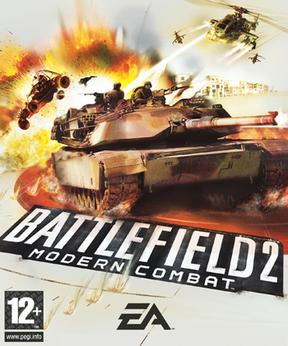
Battlefield 2: Modern Combat is a first-person shooter video game in the Battlefield series, developed by DICE and published by Electronic Arts. Modern Combat is the first Battlefield game for video game consoles and the first to offer a full single-player campaign. Despite its name the game is neither a port nor a spin-off of Battlefield 2 which was in development at the same time.

Tom Clancy's Splinter Cell: Double Agent is a 2006 stealth game developed by Ubisoft Milan and Ubisoft Shanghai, and published by Ubisoft. The Splinter Cell series, endorsed by American author Tom Clancy, follows Sam Fisher, an agent employed by a black-ops division of the National Security Agency (NSA), dubbed Third Echelon. The game was released for GameCube, PlayStation 2, Xbox and Xbox 360 in October 2006. The Wii and Windows versions were released in November 2006. A PlayStation 3 version was released in March 2007.
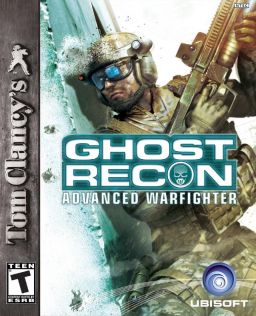
Tom Clancy's Ghost Recon Advanced Warfighter (GRAW) is a tactical shooter video game released for the Xbox 360, Xbox, PlayStation 2 and Microsoft Windows in 2006. As in previous Ghost Recon games, players command their team while neutralizing hostile forces and completing various mission objectives. These objectives can range from escorting friendly units across the map to rescuing hostages or taking out enemy artillery.
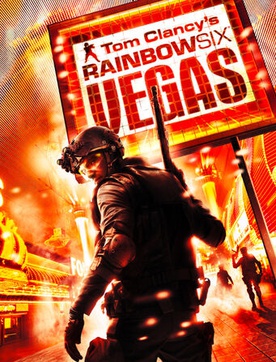
Tom Clancy's Rainbow Six: Vegas is the sixth game in the Rainbow Six series of video games. It was released in November 2006 for the Xbox 360, December 2006 for Windows, and in June 2007 for the PlayStation 3 and PlayStation Portable. The game's storyline follows a new team that is dispatched to Las Vegas, Nevada to defeat international terrorist Irena Morales and her army of mercenaries that are repeatedly attacking key locations in the city. A sequel developed by Ubisoft Montreal was released on Xbox 360, and PlayStation 3 consoles in March 2008 and on PC in April 2008. The game is also playable on Xbox Series X with online features still available.

Just Cause is a 2006 third-person action-adventure game set in an open world environment. It is developed by Swedish developer Avalanche Studios and published by Eidos Interactive, and is the first game in the Just Cause series. It was released for Microsoft Windows, PlayStation 2, Xbox, and Xbox 360. The area explored during the game is described as being over 1,024 km2 (395 sq mi) in size, with 21 story missions and over 300 side missions to complete.

Army of Two is a third-person shooter video game developed and published by Electronic Arts and released on March 6, 2008 for the Xbox 360 and PlayStation 3 consoles. The game is centered upon two mercenaries fighting through war, political turmoil, and a conspiracy from 1993 to 2009. Focusing on cooperative strategies, Army of Two's main feature is the necessity to use coordinated teamwork to accomplish the game's goals. While the game is meant to be played with another human as a partner, a "Partner Artificial Intelligence" (PAI) is also included and programmed to follow the player's strategies. Dependence on a partner is so pronounced that most objectives are impossible to complete without it.

Mercenaries 2: World in Flames is an action-adventure video game developed by Pandemic Studios and published by Electronic Arts for PlayStation 2, PlayStation 3, Xbox 360 and Microsoft Windows. It is the sequel to 2005's Mercenaries: Playground of Destruction. The game is a third-person shooter with an open world, set in a fictionalized war-torn Venezuela. The game's primary objective is to kill the President of Venezuela whose betrayal of the protagonist mercenary acted as a stepping stone to their current position.
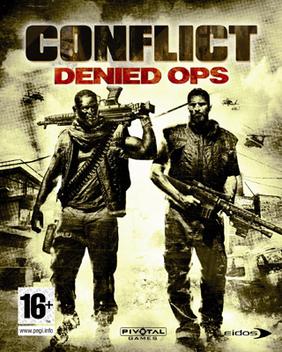
Conflict: Denied Ops is a tactical shooter video game developed by Pivotal Games and published by Eidos Interactive for Microsoft Windows, PlayStation 3 and Xbox 360. It is the fifth and final installment in the Conflict series. Originally, the game was to be called "Crossfire" but was later changed. It released on February 8, 2008, in Europe, February 12, 2008, North America, February 21, 2008, in Australia and January 16, 2009, in Japan.
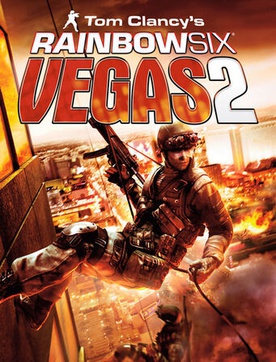
Tom Clancy's Rainbow Six: Vegas 2 is the seventh installment in the Rainbow Six series. It is a first-person shooter video game and the sequel to Tom Clancy's Rainbow Six: Vegas. It was announced by Ubisoft on November 20, 2007. The game was released for the Xbox 360 and PlayStation 3 in March 2008. The Microsoft Windows version, however, was delayed until April 2008. It was released in Japan on April 24, 2008, for the Xbox 360 and on May 29, 2008, for the PlayStation 3. This game is also available for Xbox One and Xbox Series X/S via backward compatibility.

Army of Two: The 40th Day is a third-person shooter video game developed by EA Montreal and published by Electronic Arts for PlayStation 3 and Xbox 360. The game was also released for PlayStation Portable, which was developed by Buzz Monkey. It is the sequel to Army of Two. Army of Two: The 40th Day was released in 2010 worldwide.

Blacklight: Tango Down is a dystopian cyberpunk-themed online multiplayer first-person shooter video game developed by Zombie Studios and published by Ignition Entertainment. The game was released on July 7, 2010 on Xbox 360 as a downloadable title, and was released on Microsoft Windows on July 14, 2010. The game was also released in late 2010 for the PlayStation 3. The PC version is the one to receive all three patches, where as the Xbox 360 received only the first two patches, and the PlayStation 3 version received no patches, being at retail, launch day version.

Hunted: The Demon's Forge is an action role playing game set in a dark fantasy world. The game was developed by inXile Entertainment and published by Bethesda Softworks for PlayStation 3, Xbox 360 and Microsoft Windows.

Hard Corps: Uprising is a run and gun video game developed by Arc System Works and published by Konami for the Xbox 360 and the PlayStation 3. The game was released digitally on Xbox Live Arcade on February 16, 2011 and on the PlayStation Network in March 2011. In Hard Corps: Uprising, the player assumes the role of an elite soldier simply called Bahamut, along with other main characters. Konami has added three additional player characters via downloadable content.

Apache: Air Assault is a combat flight simulator video game for Microsoft Windows, PlayStation 3 and Xbox 360. It was developed by then-Russian developer Gaijin Entertainment, which is most famous for its World War II MMO-game War Thunder and published by Activision.

Earth Defense Force: Insect Armageddon is a third-person shooter developed by Vicious Cycle Software, and published by D3 Publisher, for the PlayStation 3, Xbox 360 and Microsoft Windows. It is a spinoff built around the concept of "What if Americans made EDF" and has no story or setting connection to the numbered series.
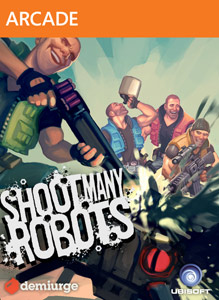
Shoot Many Robots is a video game developed by Demiurge Studios and published by Ubisoft for Xbox Live Arcade, PlayStation Network, and Microsoft Windows via Steam. It is the first original release from the developer which previously did support work on games such as Rock Band, BioShock, and Mass Effect. Shoot Many Robots was released in March 2012 for XBLA and PSN, and a month later for Steam. The Xbox 360 version received mixed reviews–a Metacritic score of 67–while other versions received too little attention to result in a meaningful rating.

Warhammer 40,000: Kill Team is a top-down shooter game with twin-stick control, set in the Warhammer 40,000 future fantasy universe. Players play as Space Marines attempting to halt an Ork invasion spaceship, facing orks and, later, Tyranids. Four Space Marine classes are playable Sternguard Veteran, Techmarine, Vanguard Veteran and Librarian. The first two focusing on Shooting the later two on melee. The game supports single player and same screen multiplayer modes.

Marvel Avengers: Battle for Earth is a video game developed by Ubisoft Quebec and published by Ubisoft for the Xbox 360 and the Wii U. The game is heavily based on the "Secret Invasion" storyline in Marvel comic books. The game was announced after the cancellation of the original The Avengers game based on the 2012 film of the same name, being developed by THQ. Battle for Earth was released in North America on October 30, 2012 for the Xbox 360, followed by the Wii U version on December 4. It was the first and currently only Marvel video game to be published by Ubisoft.

Family Guy: Back to the Multiverse is an action-adventure third-person shooter video game developed by Heavy Iron Studios and published by Activision. The game is based on the American animated television series Family Guy, including the episode "Road to the Multiverse", and was also a continuation of the episode "The Big Bang Theory". It also featured the return of Stewie's evil half-brother Bertram, who was killed in the show. The game was released in North America on November 20, 2012, in Australia on November 21, 2012, and in Europe on November 23, 2012, for Microsoft Windows, PlayStation 3, and Xbox 360. Versions for a Nintendo 3DS and Wii were planned but canceled. It was the first Family Guy console game since Family Guy Video Game! in 2006.

Army of Two is a third-person shooter video game series developed by EA Montreal. The first game in the series, Army of Two, was released on March 6, 2008 for the Xbox 360 and PlayStation 3 consoles. Focusing on cooperative strategies, Army of Two's main feature is the necessity to use coordinated teamwork to accomplish the game's goals. While the game is meant to be played with another human as a partner, a "Partner Artificial Intelligence" (PAI) is also included and programmed to follow the player's strategies. Dependence on a partner is so pronounced that most objectives are impossible to complete without it. A sequel, Army of Two: The 40th Day, was released in January 2010 in North America and Europe. The third game in the series, Army of Two: The Devil's Cartel, was released on March 26, 2013 by Electronic Arts for the Xbox 360 and PlayStation 3.




















